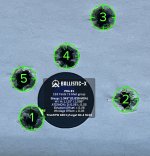Might be two overlapping phenomenon. It's common to get a hard carbon ring at the step, and brushes and patches can't conform into the sharp corner. I had one of those in my AR match barrel that I first saw when I got a borescope, and it annoyed me that it wouldn't come out (borescopes often introduce new worries). But when Gunzilla was first introduced, I got a free sample of it at Camp Perry and decided to try cleaning that barrel with it. Nothing unexpected happened right away. Patches were coming out clean, but the ring was still there. But after I put one last wet patch in, just in case, I got called away by something and didn't get back to finish cleaning for almost 24 hours. When I did, I started with a dry patch, and it came out with a black ring around it. I got the borescope out, an lo and behold, the carbon ring was gone. Gunzilla is slow to soften carbon, but it does do it. Same with rust. It will loosen it until it falls off, but you need to give it a week sometimes to act. Once I left on business and it had six weeks to act on an old Springfield '03 bore and when I got back all the rust and carbon in several bore pits had oozed down to the bottom of the bore, so it is something for you to try. Saves a lot of frustrated elbow grease.
I think the carbon ring problem is generally worse in belted cases because they specify them so the shoulder is back enough to be sure the full range of head-to-shoulder specs won't allow shoulder contact with the chamber shoulder over the full range of the belt headspace tolerances. You may change that to headspacing on the shoulder instead of the belt if you choose, but the new ammo and fully resized ammo will leave a bit of extra room for carbon and gas blowby around the bullet when the neck expands to release the bullet. That and the sheer volume of powder burned are probably all you need to account for extra carbon build-up where you have it.
Incidentally, Slip2000 Carbon Killer is another product that will likely let you get the ring out and will do it faster (15 minutes of sitting), but it is harsher and you still need a bit of mechanical effort, so I tend to prefer letting Gunzilla and time do the work. In a pinch, though, when you haven't got the time to wait (big match in the morning), having the Carbon Killer option available may strike you as useful.
The second phenomenon will just be the buildup of copper in the first two or three inches of the bore. This is where the bullet is located when the peak of the pressure curve is reached. At that location, the bullet is experiencing the biggest pressure differential between its base and nose, which tries to squash the bullet. It isn't able to squash the bullet, but it is enough to apply some upsetting force outward against the bore, so bullet-to-bore friction peaks together with the pressure, and that rubs copper off faster than anywhere else in the bore, except in some special cases where the bore tapers down in diameter toward the muzzle or where extra rough tooling marks exist further down. I was thinking maybe if your carbon buildup extended to the start of the copper buildup portion of the bore, it might look like one big problem when it is actually two.
Incidentally, in the 1995 Precision Shooting Reloading Guide, one of the authors had a 300 WM that wouldn't shoot below 2 moa regardless of what loads or components he tried. Then, one day, he got an outside neck-turning tool and tried it on his 300 WM cases. Bingo. Its groups immediately shrank to 1 moa. The way the statistics of group error work, that would make the effects of other things he tried (powder, primers, bullets) start to be visible when the 2 moa group was covering them up.
I'm not saying that particular treatment would necessarily help your particular gun, but it is another example of the extra shoulder wiggle room of the fully resized case making consistent bullet alignment more fussy.


